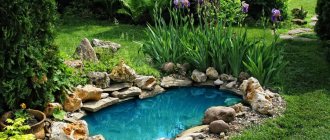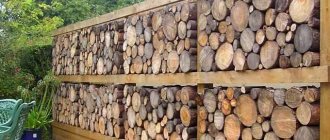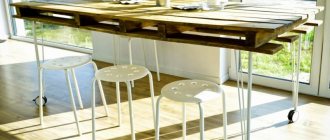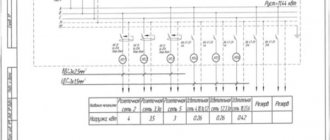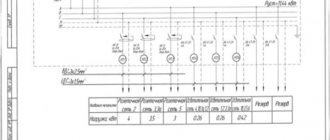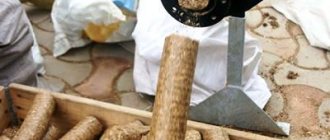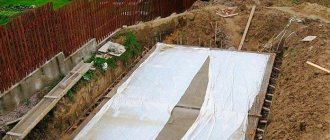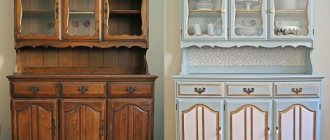Decorating a site is a favorite pastime of summer residents and homeowners. Beautiful flower beds, flower beds and even beds are a true decoration. However, nothing pleases the eye more than ponds and ponds surrounded by beautiful vegetation. And if a stream of water still comes out of it, then the corner turns into the best resting place. If you still manage to make not only a fountain with your own hands, but also beautiful lighting, put a swing or bench nearby, in the evenings all the inhabitants will gather on this patch.
This fountain is DIY and so is the lighting: a waterproof LED light with remote control for changing colors
Types of fountains
This landscape design element can fall into one of several classifications. Depending on the general characteristics, the following types of fountains are distinguished:
- Submersible. In this case, most often they use a real pond that is present on the site. It could be a small pond. A pump is installed in it, which will take water and then supply it up through the pipe;
- Stationary. The object can decorate any country house. The bottom and banks are decorated with artificial stone, pebbles and other natural materials;
- With falling water. In fact, this variety is not a classic fountain, but a waterfall. Water most often flows onto a cascade of stones, and the cycle itself is closed in the bowl.
Depending on how exactly the water is supplied, there are several more varieties:
- jet fountain (the direction is strictly upward, the height of the jets is determined by the pressure level);
- bell (thanks to the nozzle, water shoots up in the form of spherical disks, which form a dome at the intersection);
- tulip (the flow is directed upward at a certain angle so that a funnel is formed in the center, imitating a flower);
- fishtail (similar to the shape of a tulip, but the water shoots out in separate streams);
- ring (the pipe is installed in a circle, it has holes with nozzles at equal distances from each other);
- spinner (rotating nozzles imitate twisted spirals);
- Roman fountain (has several different levels).
Merry Pond
The presence of a pond on the site already charms and pleases. But the fountain for the pond is its special decoration. This motor revives the motionless surface of the water, makes it move, play, reflecting glare from the sun's rays.
If there is already a pond on the site, then installing a fountain will not be difficult. The fountain pump runs on electricity, so power points should be provided.
If plants live in the pond, then the water stream should be located 50 cm from them. The shoreline of the pond must correspond to the overall landscape design of the entire site.
How to choose a place on the site
When choosing a location for a garden fountain, you need to consider several main factors:
- The area on which the object will be located must be in a place protected by shadow. It is undesirable for the water tank to be located directly under the sun's rays, otherwise flowering will quickly begin.
- In this case, the trees should be located at a slight distance. A developed root system can harm the system. In addition, leaves and branches will get into the water.
- Construction should not start next to the house. Constant humidity can contribute to the formation of mold on the walls.
- Preference is given to areas protected from drafts so that splashes do not fly in different directions.
- If we talk about where it is better to place it - in sand or soil, you need solid soil that will not “walk”.
Ideally, the place where the fountain will be located should be visible from different parts of the garden. An object surrounded by flower beds or small shrubs will look good. They also provide partial shade, which is necessary to protect against flowering.
Near the rest area
The fountain is best placed next to the seating area. This could be a gazebo or patio. It is advisable that this place be viewed from the windows of the living room, so that you can once again admire such beauty up close.
The pond in which the fountain splashes will look more natural in the lowest part of the site.
It should not be placed entirely in the sun, where water may bloom, or in deep shade, where it is less decorative. The best place for a fountain will be partial shade.
You should not build this object under deciduous trees; the leaves will pollute the fountain bowl, and the roots can damage it.
The fountain should be positioned so that it reflects other decorative garden objects or beautiful plants.
Necessary equipment
Designing fountains involves selecting the required equipment and future location. Much depends on the area of the site, the relief textures, and other features (garden fountain: cascading, jet, etc.).
Whatever type of object is planned, several basic details will be required for its construction:
- water tank;
- nozzle;
- fountain pump.
To construct the structure, you can purchase a ready-made container. It can be plastic, metal, stone. It is also possible to build a reservoir directly on the ground.
Next, you need to decide on the power of the pump and how the jet forms a pattern. The type of nozzles used and the height to which the water will rise will depend on the desired picture.
The pump can be surface or submersible. In the first case, it is located outside the boundaries of the reservoir, which makes access easier if repairs are required. In the second case, the equipment is installed under water.
It is also necessary to take into account the planned performance of the device:
- to create jets about 50 cm high, a pump that pumps up to 850 liters per hour will be sufficient;
- in order for the water to rise up to 100 cm, the productivity must be 2 thousand liters;
- a pump pumping 3-5 thousand liters per hour will create jets with a height of 1.5 to 2 m;
- the most powerful equipment (8 thousand liters per hour) raises water up to 3 m in height.
Other technical elements include a filtration system. It clears the water of small debris and prevents it from blooming. The fountain lamp is already a decorative object.
Building a fountain at your dacha with your own hands
Before starting work, you should decide on the volume of the reservoir. Next, they proceed to the first stage - preparing a foundation pit, taking into account the required width, length and depth. Water should not pour out of the structure, so the recess should be sufficient.
Next, the prepared bottom is covered with a layer of sand. The walls are covered with bricks. If you are using a ready-made tank, this step can be skipped. After this, the entire surface is lined with a high-quality dense film that will not allow moisture to pass through.
Emergency drainage should be provided in advance. After all, after heavy rain, the water level can rise so much that it begins to intensively pour out of the reservoir onto the garden plot.
All joints and seams are sealed with sealant to prevent possible leaks. Next, stones are laid on the bottom. Pebbles with a smooth polished surface will look more harmonious.
At the next stage, install a hose and pipe with nozzles, and then a pump that will drive the water supply. Devices are most often already equipped with built-in filters. Then the backlight is installed (if planned), the container is filled with water and a test run of the system is carried out. Last on the list is decoration.
Another simple and quick way to independently arrange a reservoir involves purchasing ready-made fountain installations. The kit includes all the necessary equipment: reservoir, pump, etc.
In this case, a minimum of effort will be required from the owner. It will be enough to choose the right place, carefully study the instructions and install the equipment in accordance with it. The only difficulty will be establishing communications.
Decor options for a country or garden fountain
After installing the main elements, you can begin the final part. The improvement of the reservoir and design ideas depend only on the personal preferences of the owner and his capabilities.
You can decorate an object with both living moisture-loving plants and artificial elements made from natural materials. Stone and clay figurines are often used as decoration; if size allows, small sculptures are used.
Another way to decorate is to arrange a fountain with lighting. For this purpose, lamps protected from water are used, as well as floating lamps or light strips.
There are several basic details that you need to pay attention to when decorating a pond:
- if a finished object made of polystone is installed, no additional decorations will be required;
- when using natural stones, you can choose both large cobblestones and small pebbles (unprocessed samples with sprouted moss look more natural);
- When decorating with stones, more than two rocks are not used at the same time;
- aquatic plants are placed on the water;
- Decorative grottoes can be used for decoration.
Full bowl
The container with water for the functioning of the fountain can be made of any material. Her choice depends on the desires and financial capabilities of the owners of the site.
Buy a plastic bowl of the required size in a store or construction market. For a fountain container, you can use an unnecessary bathtub, a barrel, a car tire, or even a basin.
The bowl can be made from a cement mixture or using durable reinforced film. The main thing is that the container where the water will circulate is sealed, durable and resistant to temperature changes.
To install such a container you need to dig a hole or pit. This will depend on the size of the container. A layer of fine gravel is poured onto the bottom of the recess, then sand is added and compacted tightly.
A bowl is installed in this recess so that the ground level is several cm below its edges. The fountain pump with installed nozzle is installed in the center of the container.
A submersible pump with a flow regulator, from which a plastic or rubber tube with a spray nozzle extends upward, is lowered to the bottom.
Pumps must be equipped with special filters. Do not fill the bowl with water all the way to the top.
Care and maintenance rules
We have already understood how the fountain works, based on the required equipment, but we should not forget that the fountain needs to be periodically looked after and serviced. To avoid equipment breakdowns and other problems, you need to follow a few simple rules:
- regardless of the type of tank (concrete, metal, plastic), you need to regularly check it for integrity;
- change the water in the bowl as it gets dirty (if there is a filtration system, this can be done less often);
- chemical cleaning agents are effective, but can harm plants or fish (if present);
- maintaining an optimal water level (in reservoirs with a closed system it quickly evaporates);
- before the onset of cold weather, the water is drained, and the structure is dismantled and sent to a place protected from moisture and frost;
- the tank itself is covered with a protective film (if cracks are detected, additional treatment will be required).
How to make a homemade one without a pump at home
In some ways, installing an artificial fountain in your dacha with your own hands without a pump is even easier. To do this, you just need to place a water pipe in the reservoir, through which the stream will shoot upward under pressure. If desired, you can even install some kind of attachment on its end.
At the same time, we must not forget that a fountain without a pump will require other efforts on the part of the owner of the site. After all, you will need to decide where the used water will be poured. If it is a natural body of water, then it will return there. In other cases, you can still provide a pump. For example, to supply water to a well or other suitable place.
Enchanting effect
Fountains are decorative in appearance, especially during the day. With the onset of dusk, their undeniable beauty hides in the darkness. But this can be corrected with the help of underwater and surface lamps.
Under artificial lighting, streams of water become magical, bewitching threads. With the help of LED waterproof lamps, the fountain turns into a fairy-tale object.
The stream of water in the fountains near the walls flows freely, gravity helps in this. The appearance of springs originating at the bottom of a reservoir can be created using nozzles that should be immersed in water.


